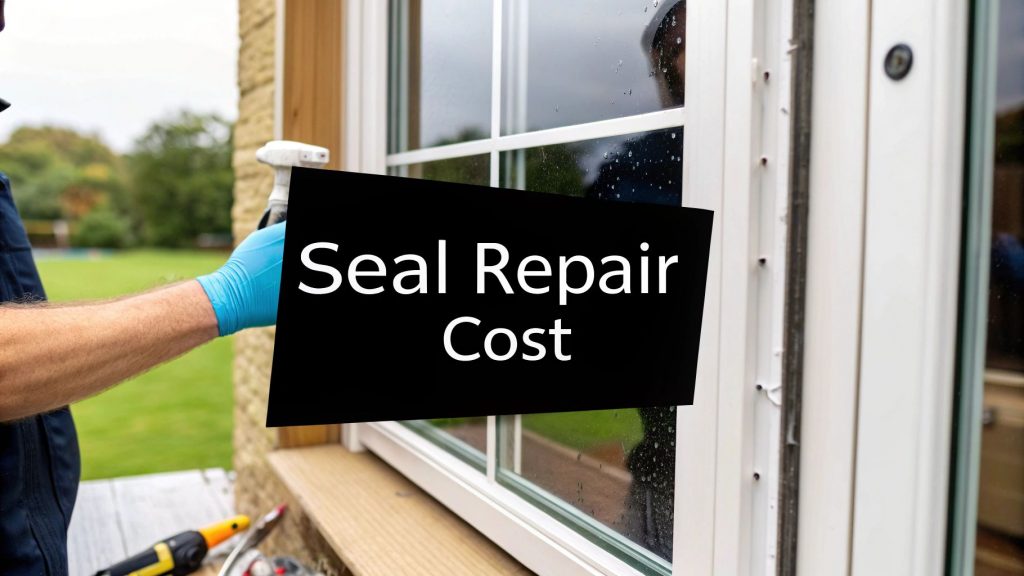A broken window seal is way more than just an annoying patch of fog you can't wipe away—it's a sign that your home is leaking precious energy. While the typical cost to fix a window seal can run anywhere from $40 to $120, that's really just a starting point for folks here in Seattle and the greater Puget Sound area, where our damp climate can accelerate damage.
Understanding Your Window Seal Repair Costs
When you first spot that tell-tale condensation trapped between the panes of your window, your mind probably jumps straight to the repair bill. It's a valid concern for any Seattle homeowner. A failed seal means the insulating gas barrier is gone, forcing your furnace and AC to work overtime just to keep you comfortable. Getting a handle on the potential cost is the first step to fixing it right.
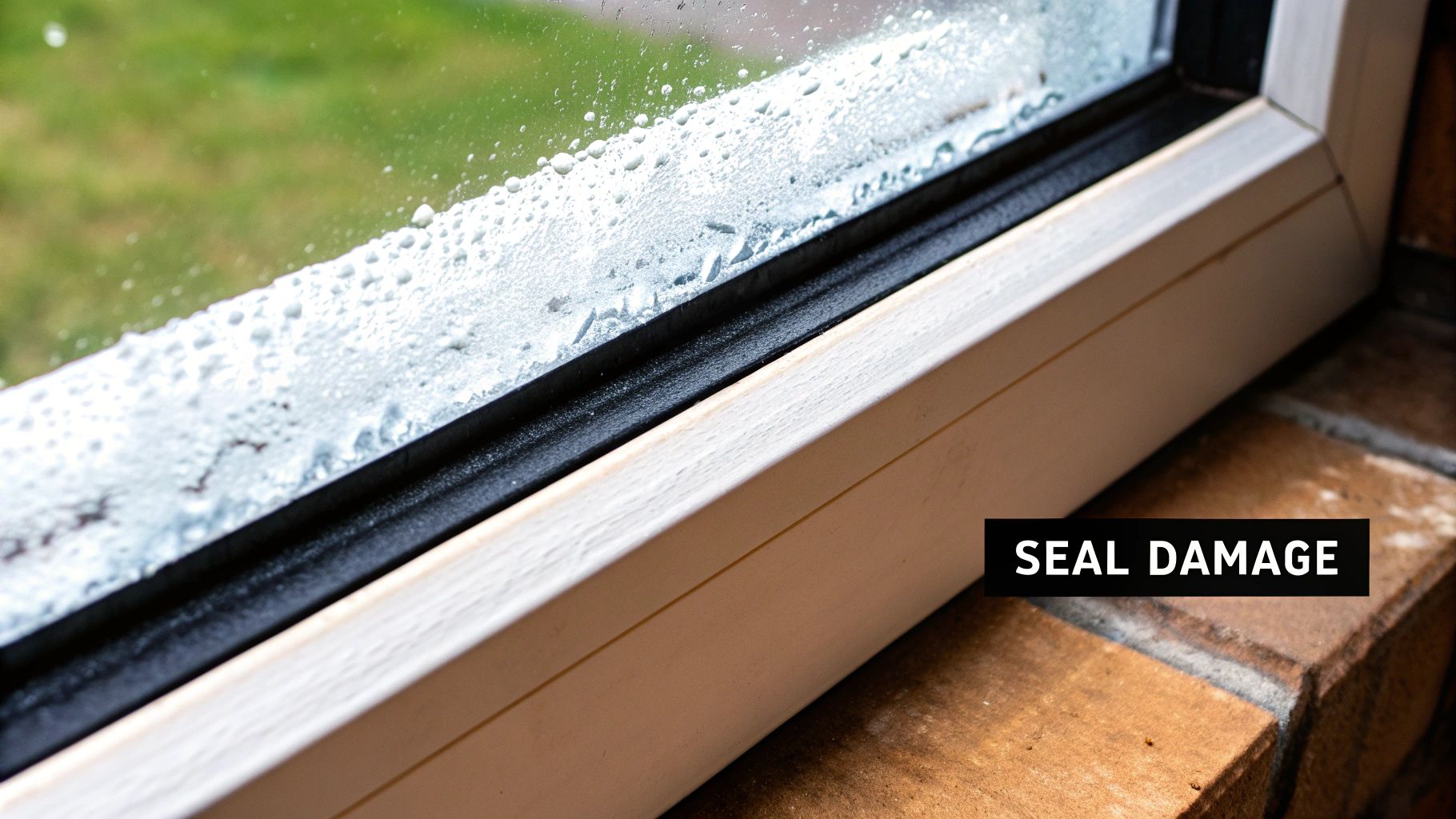
The final price tag can swing quite a bit depending on a few key factors. It's a bit like taking your car to the mechanic; patching a tire is a whole different ballgame than a full engine replacement. The same logic applies to your windows, especially given the unique environmental challenges in our region.
Key Factors Influencing Your Bill
Several variables come into play when a professional puts together your quote. Things like the window's type, its size, and even where it's located in your house will all affect the final invoice. It makes sense, right? A small, easy-to-reach window on the ground floor is going to be a much simpler (and cheaper) job than a huge picture window on the second story that needs special ladders or scaffolding to manage Seattle’s hilly terrain.
Across the U.S., you can expect to pay between $40 and $120 to repair a broken window seal, with the median cost sitting around $69. But for those tricky, hard-to-reach windows, you might see an extra $75 to $150 added to the bill. You can dig into more window repair cost insights on Airtasker.com.
To make it easier, let's break down the main things that will shape your professional quote here in the Pacific Northwest.
Quick Look at Window Seal Repair Cost Factors
Here's a quick table summarizing the main variables that will determine your total cost.
| Influencing Factor | Typical Cost Impact |
|---|---|
| Window Size & Type | Larger windows or custom shapes require more materials and labor, driving up the price. |
| Glass Type | Double-pane is standard, but triple-pane, tempered, or gas-filled units are more expensive to repair. |
| Window Accessibility | A ground-floor window is cheap to fix; a third-story window requiring a lift will cost significantly more. |
| Frame Material | Wood frames might require extra work (like sanding or sealing to combat rot) compared to vinyl or aluminum. |
Ultimately, each of these elements contributes to the final number you'll see on your invoice.
What Really Drives Your Final Repair Bill
Trying to nail down the exact cost to fix a window seal can feel a lot like guessing the weather in Seattle—it really depends. The final number a pro gives you isn't just pulled out of thin air; it’s based on a few key things they'll check out when they see the window in person. The biggest one? How complicated the job is.
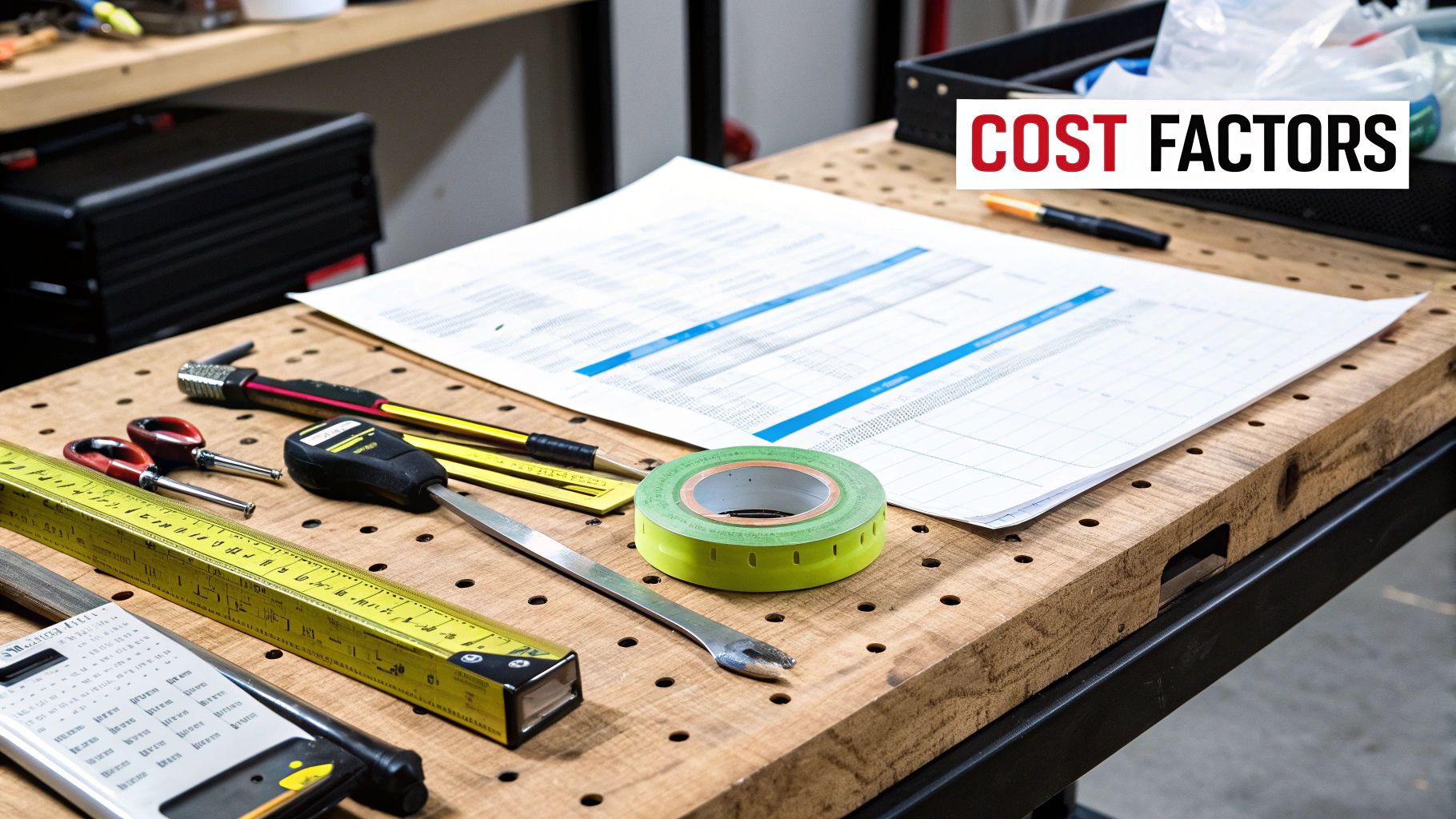
It’s one thing to fix a simple, double-hung window on the ground floor. It's a whole different ballgame for a massive, custom bay window on the second story. That second job needs scaffolding, maybe an extra set of hands for safety, and just plain more time—all of which bumps up the labor cost. Just getting to a hard-to-reach window can easily add $75 to $150 to the bill before the real work even starts.
What your window frame is made of matters, too. A modern vinyl frame is usually a quick fix. But an older wood frame? That could be a can of worms, especially with our regional moisture. We might find rot that needs to be repaired or have to sand and refinish the area to get the new seal to sit right.
Key Cost Influencers at a Glance
- Window Design: A standard rectangular window is always going to be cheaper to work on than a fancy arched or bay window.
- Window Location: Got windows on the second or third story? Expect higher labor costs. We'll need ladders, lifts, or even scaffolding to get the job done safely.
- Frame Material: Wood frames can hide extra work like rot repair. Vinyl and aluminum frames are typically more straightforward.
- Extent of Damage: A simple seal failure is one thing. But if moisture has been sneaking in for a while, it can damage the frame or the wall around it, making the project bigger and more expensive.
Here's an insider tip: a failed seal is often just a symptom. A good contractor will look for the real problem, like the house settling or the frame itself warping, which caused the seal to break in the first place. A pro trade method is to check the entire window opening for level and plumb; sometimes shimming the frame is required before replacing the glass unit. Just slapping a new seal on without fixing the root cause is a temporary patch, at best.
Honestly, the only way to know for sure what the cost to fix a window seal will be is to have an expert take a look. When you get a detailed estimate from a trusted local company like Breeze Siding, we break down all these factors so you know exactly where your money is going. No surprises, just a solid, long-lasting fix.
Spotting a Failed Window Seal Before It Gets Worse
Catching a broken window seal early is a bit like finding a slow leak in a tire; ignoring it only leads to bigger, more expensive problems down the road. The most glaring sign is that stubborn fog or condensation trapped between the glass panes—the kind you can't wipe away no matter how hard you try. This is your window's way of telling you its airtight seal has been compromised, letting moisture sneak in.
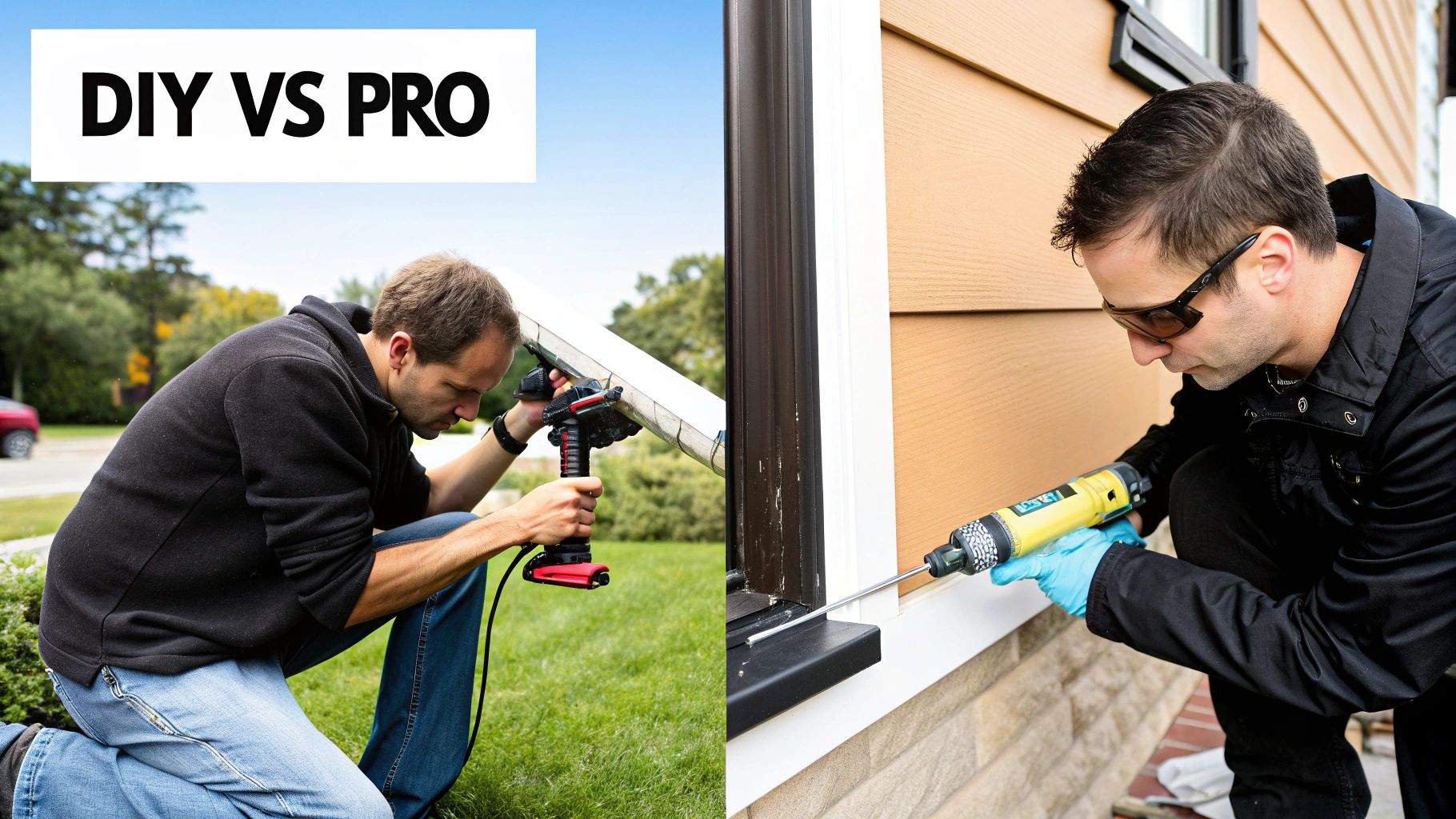
While that trapped moisture is the classic symptom, there are a few other clues homeowners often miss. If you can act on these early warnings, you can usually keep the cost to fix a window seal from ballooning.
Beyond the fog, a failed seal kills your home's insulation. The inert gas (usually argon) that once provided a thermal barrier has escaped, meaning your window can no longer effectively block outside temperatures. This hit to your energy efficiency is a major reason why getting it fixed quickly is so important. When you consider the broader health of your home's exterior, a well-sealed window is just as crucial as properly installed siding for creating a complete thermal envelope and preventing moisture intrusion.
Subtle Signs of Seal Failure
Keep an eye out for these less obvious indicators. Spotting them early can save you from moisture damage that can spread to the window frame or even the surrounding walls.
- A Persistent Draft: Do you feel a faint, cool breeze near your window, even when it’s locked tight? A simple trick is to hold a lit candle or smoke pen near the frame. If the flame or smoke dances around, you’ve probably got a leak. This kind of draft can account for up to 30% of a home's energy loss.
- Slight Visual Distortion: Look closely through the glass. Does the world outside seem a little wavy or bent? This can happen when the seal breaks, changing the pressure between the two panes and causing them to flex ever so slightly.
- Increased Outside Noise: Has your quiet living room suddenly started letting in more street noise? That insulating gas doesn't just block temperature—it also dampens sound. When it's gone, you'll notice the difference.
Catching these issues early is crucial. A failing seal that's ignored can allow moisture to saturate the window frame, leading to rot in wood frames or corrosion in metal ones, turning a simple repair into a much more complex and expensive project.
Deciding Between DIY Repair and a Professional Fix
When you first spot that frustrating fog between your window panes, the urge to grab a caulk gun and fix it yourself is totally understandable. A quick trip to the hardware store feels a lot simpler and cheaper than calling in a pro, right?
But before you start scraping away at that old seal, it's worth taking a moment to think about what you're really getting into.
The Temptation of a Quick DIY Fix
On the surface, the DIY route seems like a no-brainer for your wallet. You can pick up a quality sealant and the right tools for around $35. Easy peasy.
The catch? This isn't just a simple caulking job. Getting the old, failed sealant off without gouging the window frame or—even worse—cracking the glass takes a surprisingly steady hand. And creating a perfectly airtight seal that will actually last is much trickier than it looks. Even a tiny, invisible gap means the fog will be back before you know it, and you'll be right back where you started.
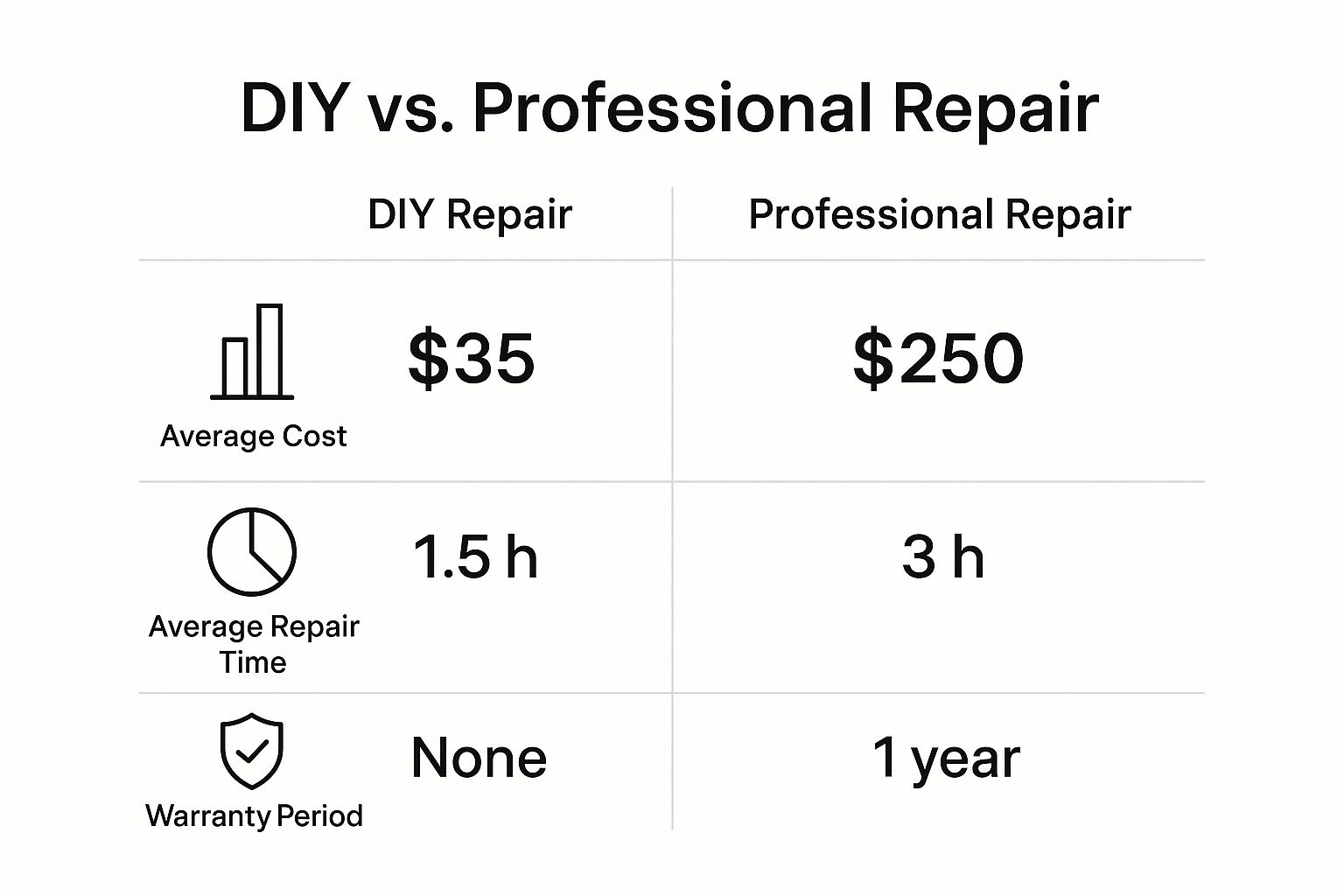
Why Calling a Pro Is Usually the Smarter Move
Hiring a professional might feel like a bigger expense upfront, but it's an investment that pays off. A pro doesn't just show up with a tube of sealant; they bring specialized tools, high-grade materials that stand up to Seattle's damp climate, and years of experience.
They know exactly what to look for and can often spot the real reason the seal failed in the first place, like a subtle warp in the frame that a DIY-er would miss.
So, how do you decide which path is right for you? This table breaks down the key differences to help you weigh your options.
DIY vs Professional Window Seal Repair
| Consideration | DIY Approach | Professional Service |
|---|---|---|
| Upfront Cost | Low (around $35 for materials) | Higher (includes labor and materials) |
| Time Investment | Several hours, plus research and shopping | Minimal for the homeowner |
| Skill Level | Moderate to high; requires precision | Expert-level knowledge and tools |
| Quality of Seal | Varies; risk of an imperfect seal | Guaranteed airtight and durable |
| Warranty | None; you're on your own if it fails | Yes, includes a guarantee on parts and labor |
| Long-Term Value | Low; often a temporary fix | High; a lasting solution that improves efficiency |
Ultimately, the choice comes down to weighing short-term savings against long-term peace of mind. While a DIY fix might feel good for a weekend, a professional repair ensures the problem is solved for good.
A pro doesn’t just patch the problem; they provide a lasting solution backed by a warranty. This guarantees you won't be dealing with the same foggy window a few months down the road. While the initial cost to fix a window seal is higher, the guaranteed results and protection against future issues make it a wise decision for any homeowner looking to protect their investment.
When a Broken Seal Signals a Bigger Problem
Sometimes, that foggy glass you're seeing is just the tip of the iceberg. A failed window seal is like a tiny, persistent leak in a dam—it lets moisture creep into places it was never meant to be. If you ignore it, this constant dampness can cause some seriously expensive damage to the entire window structure.
Think of the seal as your window's frontline defense. Once it’s breached, water starts saturating the surrounding frame from the inside out. In a damp climate like we have here in the Puget Sound, that’s a recipe for disaster.
This slow-motion attack wears down the very materials holding your window in place. What started as a simple foggy pane can quickly spiral into a much larger, structural problem that a simple seal repair just can't fix.
From Minor Leak to Major Damage
The kind of trouble moisture causes really depends on your window frame material. Each one reacts a bit differently to prolonged water exposure, but trust me, none of them handle it well.
- Wood Frames: These are by far the most vulnerable. Moisture makes the wood soften, swell, and eventually rot right through, completely wrecking the window's structural integrity.
- Vinyl Frames: Vinyl itself is water-resistant, but that doesn't stop moisture from getting behind the frame and damaging the wall. Extreme temperature swings can also cause damp vinyl to warp and crack.
- Aluminum Frames: With aluminum, persistent moisture leads to corrosion and rust. This not only looks bad but also weakens the entire frame over time.
A simple seal failure is a maintenance issue; a rotting frame is a structural problem. Spotting the signs of frame damage early helps you realize when the cost to fix a window seal is about to jump because the problem runs much deeper than just the glass.
Taking care of this underlying frame damage is non-negotiable. On average, window frame repairs can run from $150 to $600, and a full-on replacement could cost you $1,000 or more. You can get a better sense of these numbers by checking out these typical window frame repair costs on HomeGuide.
Investing in a proper frame repair when you replace the seal is the smart move. It saves you from the much bigger headache and expense of a full window installation down the road.
When you fix a failed window seal, you’re not just clearing up a foggy view. You're making a smart investment in your home's health and your wallet.
Think of your window seals as the silent guardians of your home's insulation. They form a crucial barrier that keeps the chilly Seattle air out in the winter and the heat out in the summer. A good seal means your HVAC system doesn't have to work overtime, which translates directly into lower energy bills.
But it goes deeper than that. Addressing a busted seal right away stops moisture in its tracks. This simple fix can prevent much bigger, more expensive problems down the road, like rotted window frames or water damage inside your walls. A holistic approach is best practice; ensuring your windows are sealed is a critical part of maintaining the building envelope, just as crucial as having well-maintained siding to protect the larger wall structure.
A timely fix is one of the smartest maintenance decisions you can make. It protects your home’s structural integrity and supports modern energy-efficiency standards, ensuring your investment pays dividends for years.
It's no surprise that the global market for high-quality window seals is massive. Valued at USD 28.5 billion in 2023, it's only expected to grow as more homeowners catch on to the benefits. You can learn more about the growing window seal market on Verified Market Research. This just goes to show how essential this one small component really is.
Your Top Questions About Window Seal Costs and Repairs
Even after you've decided how to handle a foggy window, a few questions usually pop up. Getting straight answers helps you feel good about the decision and understand why a professional fix is worth it. Let's dig into the most common ones we hear.
How Long Should a New Window Seal Last?
A professionally installed window seal should give you a good 10 to 20 years of clear views.
That lifespan really depends on a few things: the quality of the materials, how skilled the installer is, and our local climate. Here in the Seattle area, that persistent dampness and temperature fluctuation is always a factor. High-quality sealants and a proper, careful application are what make all the difference.
Can I Just Replace the Seal on a Double-Pane Window?
This is a great question. For modern double-pane windows, the two glass panes and the seal are all one piece—a factory-sealed unit called an Insulated Glass Unit (IGU). It's often filled with an insulating gas like argon.
While you might see "defogging" services advertised, the industry best practice and most permanent fix is to replace the entire IGU. Just slapping new sealant on the outside edge won't get rid of the moisture trapped between the panes, and it definitely won't restore the insulating gas you've lost.
The most effective way to fix a failed seal in a double-pane window is by replacing the insulated glass unit. This gets your window's clarity and energy efficiency back on track without the cost of replacing the entire frame.
Does Homeowners Insurance Cover a Failed Window Seal?
Typically, no. Homeowners insurance usually sees a failed window seal as a maintenance issue that comes from normal wear and tear over time.
However, there's an exception. If the seal broke because of something your policy does cover, like a tree branch hitting it during a big storm, you might be in luck. It’s always best to call your insurance agent and check the specifics of your policy to be sure.
If you're dealing with foggy windows and want a solution that lasts, our team at Breeze Siding is ready to help. We offer expert window services to bring back your home's comfort and efficiency in the Seattle area. Contact us today for a free on-site estimate!

